TARDIS Project Lessons-Learned Report
VerifiedAdded on 2023/04/04
|13
|2932
|200
AI Summary
This report discusses the key successes and shortcomings of the TARDIS healthcare organization's information management system. It highlights the achievements in data integration, confidentiality policy, and internal servers, as well as the shortcomings in information management strategy, data protection plan, and digitization. The report also provides solutions to improve the organization's information management system.
Contribute Materials
Your contribution can guide someone’s learning journey. Share your
documents today.
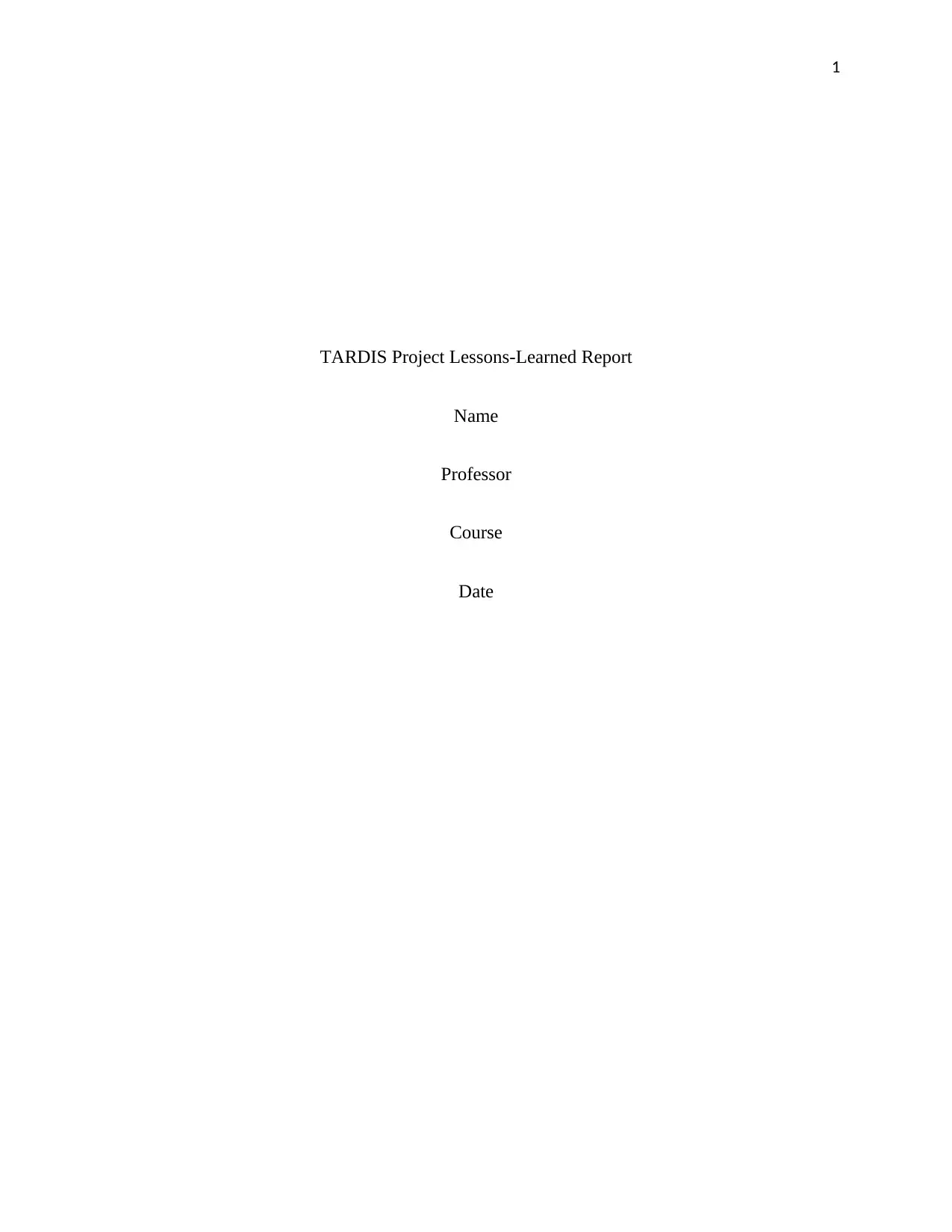
1
TARDIS Project Lessons-Learned Report
Name
Professor
Course
Date
TARDIS Project Lessons-Learned Report
Name
Professor
Course
Date
Secure Best Marks with AI Grader
Need help grading? Try our AI Grader for instant feedback on your assignments.
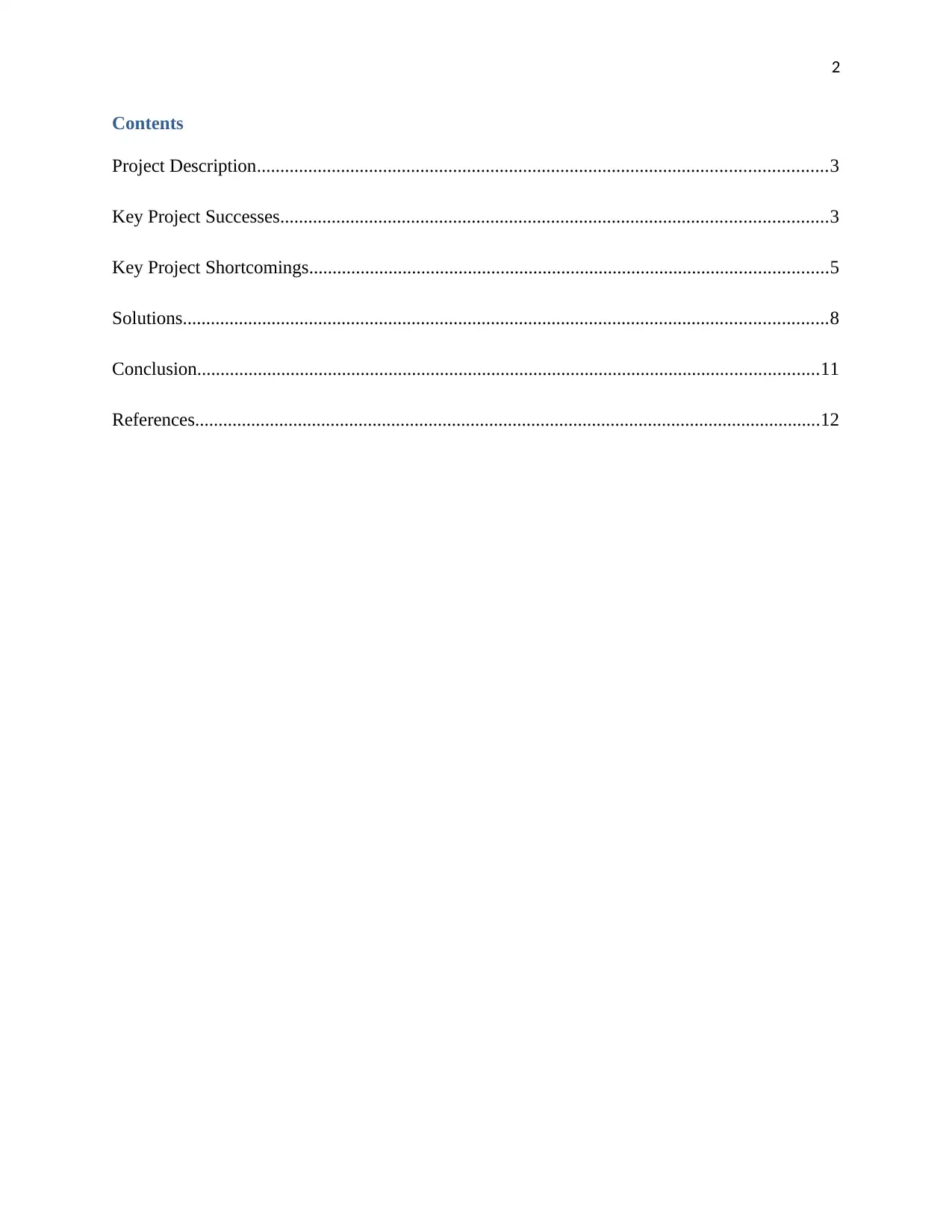
2
Contents
Project Description..........................................................................................................................3
Key Project Successes.....................................................................................................................3
Key Project Shortcomings...............................................................................................................5
Solutions..........................................................................................................................................8
Conclusion.....................................................................................................................................11
References......................................................................................................................................12
Contents
Project Description..........................................................................................................................3
Key Project Successes.....................................................................................................................3
Key Project Shortcomings...............................................................................................................5
Solutions..........................................................................................................................................8
Conclusion.....................................................................................................................................11
References......................................................................................................................................12
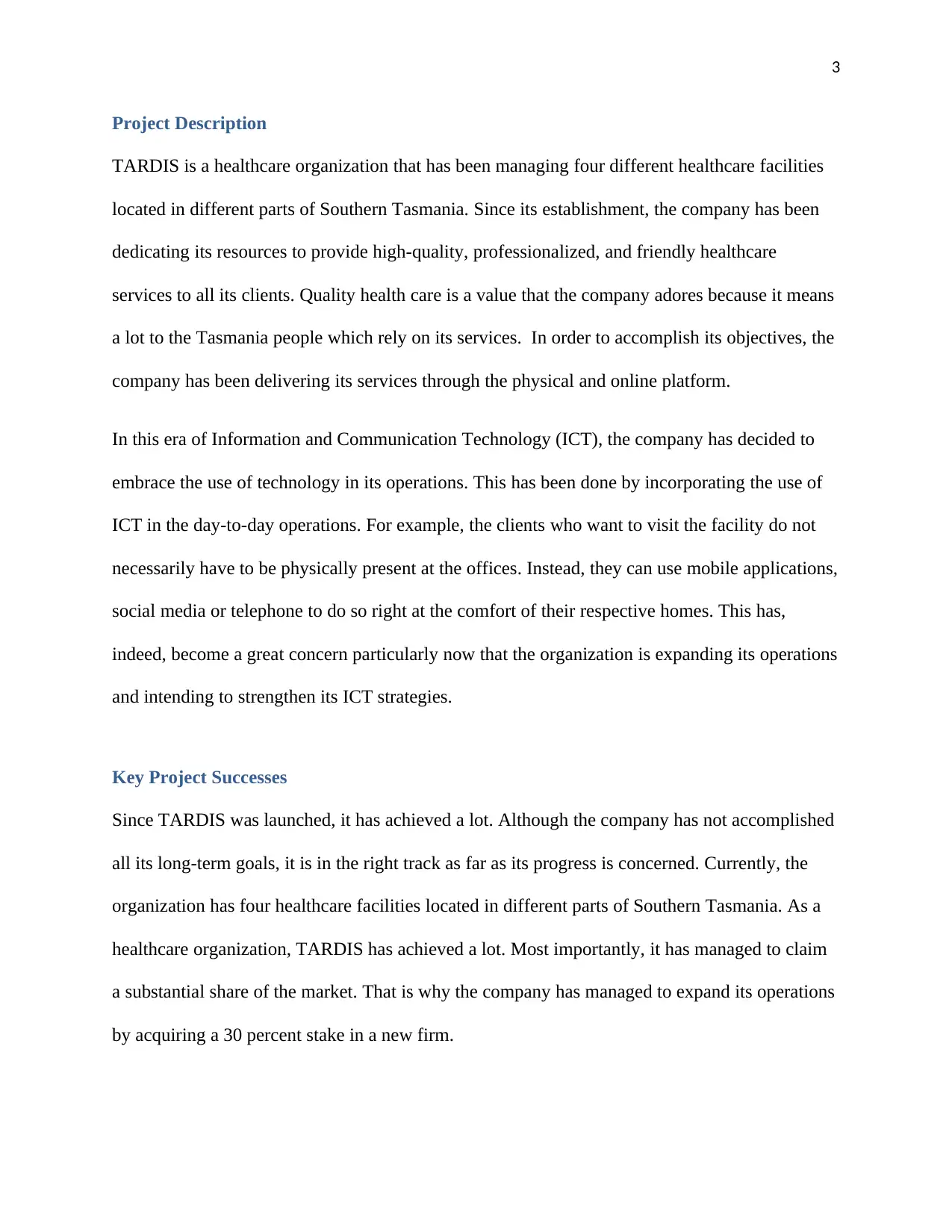
3
Project Description
TARDIS is a healthcare organization that has been managing four different healthcare facilities
located in different parts of Southern Tasmania. Since its establishment, the company has been
dedicating its resources to provide high-quality, professionalized, and friendly healthcare
services to all its clients. Quality health care is a value that the company adores because it means
a lot to the Tasmania people which rely on its services. In order to accomplish its objectives, the
company has been delivering its services through the physical and online platform.
In this era of Information and Communication Technology (ICT), the company has decided to
embrace the use of technology in its operations. This has been done by incorporating the use of
ICT in the day-to-day operations. For example, the clients who want to visit the facility do not
necessarily have to be physically present at the offices. Instead, they can use mobile applications,
social media or telephone to do so right at the comfort of their respective homes. This has,
indeed, become a great concern particularly now that the organization is expanding its operations
and intending to strengthen its ICT strategies.
Key Project Successes
Since TARDIS was launched, it has achieved a lot. Although the company has not accomplished
all its long-term goals, it is in the right track as far as its progress is concerned. Currently, the
organization has four healthcare facilities located in different parts of Southern Tasmania. As a
healthcare organization, TARDIS has achieved a lot. Most importantly, it has managed to claim
a substantial share of the market. That is why the company has managed to expand its operations
by acquiring a 30 percent stake in a new firm.
Project Description
TARDIS is a healthcare organization that has been managing four different healthcare facilities
located in different parts of Southern Tasmania. Since its establishment, the company has been
dedicating its resources to provide high-quality, professionalized, and friendly healthcare
services to all its clients. Quality health care is a value that the company adores because it means
a lot to the Tasmania people which rely on its services. In order to accomplish its objectives, the
company has been delivering its services through the physical and online platform.
In this era of Information and Communication Technology (ICT), the company has decided to
embrace the use of technology in its operations. This has been done by incorporating the use of
ICT in the day-to-day operations. For example, the clients who want to visit the facility do not
necessarily have to be physically present at the offices. Instead, they can use mobile applications,
social media or telephone to do so right at the comfort of their respective homes. This has,
indeed, become a great concern particularly now that the organization is expanding its operations
and intending to strengthen its ICT strategies.
Key Project Successes
Since TARDIS was launched, it has achieved a lot. Although the company has not accomplished
all its long-term goals, it is in the right track as far as its progress is concerned. Currently, the
organization has four healthcare facilities located in different parts of Southern Tasmania. As a
healthcare organization, TARDIS has achieved a lot. Most importantly, it has managed to claim
a substantial share of the market. That is why the company has managed to expand its operations
by acquiring a 30 percent stake in a new firm.
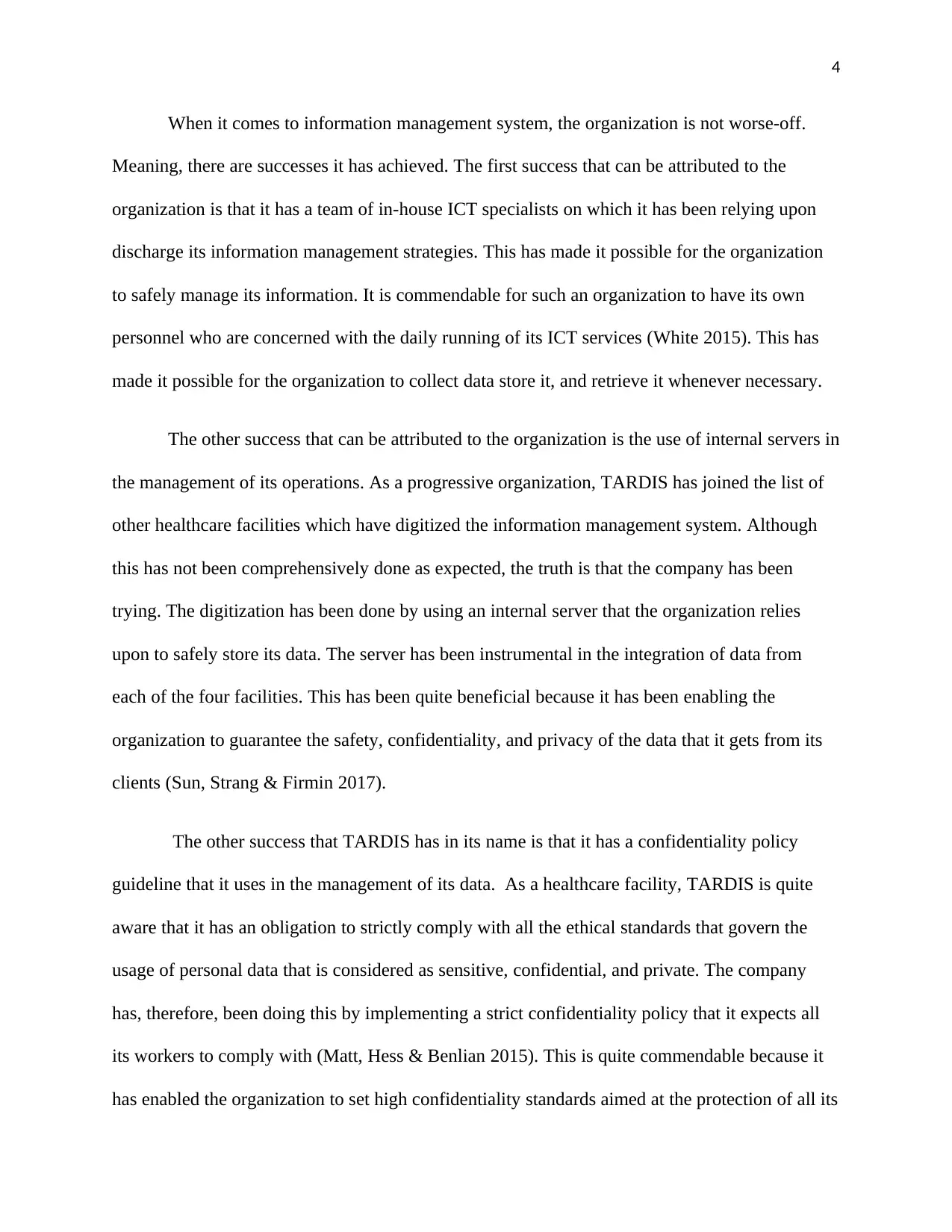
4
When it comes to information management system, the organization is not worse-off.
Meaning, there are successes it has achieved. The first success that can be attributed to the
organization is that it has a team of in-house ICT specialists on which it has been relying upon
discharge its information management strategies. This has made it possible for the organization
to safely manage its information. It is commendable for such an organization to have its own
personnel who are concerned with the daily running of its ICT services (White 2015). This has
made it possible for the organization to collect data store it, and retrieve it whenever necessary.
The other success that can be attributed to the organization is the use of internal servers in
the management of its operations. As a progressive organization, TARDIS has joined the list of
other healthcare facilities which have digitized the information management system. Although
this has not been comprehensively done as expected, the truth is that the company has been
trying. The digitization has been done by using an internal server that the organization relies
upon to safely store its data. The server has been instrumental in the integration of data from
each of the four facilities. This has been quite beneficial because it has been enabling the
organization to guarantee the safety, confidentiality, and privacy of the data that it gets from its
clients (Sun, Strang & Firmin 2017).
The other success that TARDIS has in its name is that it has a confidentiality policy
guideline that it uses in the management of its data. As a healthcare facility, TARDIS is quite
aware that it has an obligation to strictly comply with all the ethical standards that govern the
usage of personal data that is considered as sensitive, confidential, and private. The company
has, therefore, been doing this by implementing a strict confidentiality policy that it expects all
its workers to comply with (Matt, Hess & Benlian 2015). This is quite commendable because it
has enabled the organization to set high confidentiality standards aimed at the protection of all its
When it comes to information management system, the organization is not worse-off.
Meaning, there are successes it has achieved. The first success that can be attributed to the
organization is that it has a team of in-house ICT specialists on which it has been relying upon
discharge its information management strategies. This has made it possible for the organization
to safely manage its information. It is commendable for such an organization to have its own
personnel who are concerned with the daily running of its ICT services (White 2015). This has
made it possible for the organization to collect data store it, and retrieve it whenever necessary.
The other success that can be attributed to the organization is the use of internal servers in
the management of its operations. As a progressive organization, TARDIS has joined the list of
other healthcare facilities which have digitized the information management system. Although
this has not been comprehensively done as expected, the truth is that the company has been
trying. The digitization has been done by using an internal server that the organization relies
upon to safely store its data. The server has been instrumental in the integration of data from
each of the four facilities. This has been quite beneficial because it has been enabling the
organization to guarantee the safety, confidentiality, and privacy of the data that it gets from its
clients (Sun, Strang & Firmin 2017).
The other success that TARDIS has in its name is that it has a confidentiality policy
guideline that it uses in the management of its data. As a healthcare facility, TARDIS is quite
aware that it has an obligation to strictly comply with all the ethical standards that govern the
usage of personal data that is considered as sensitive, confidential, and private. The company
has, therefore, been doing this by implementing a strict confidentiality policy that it expects all
its workers to comply with (Matt, Hess & Benlian 2015). This is quite commendable because it
has enabled the organization to set high confidentiality standards aimed at the protection of all its
Secure Best Marks with AI Grader
Need help grading? Try our AI Grader for instant feedback on your assignments.
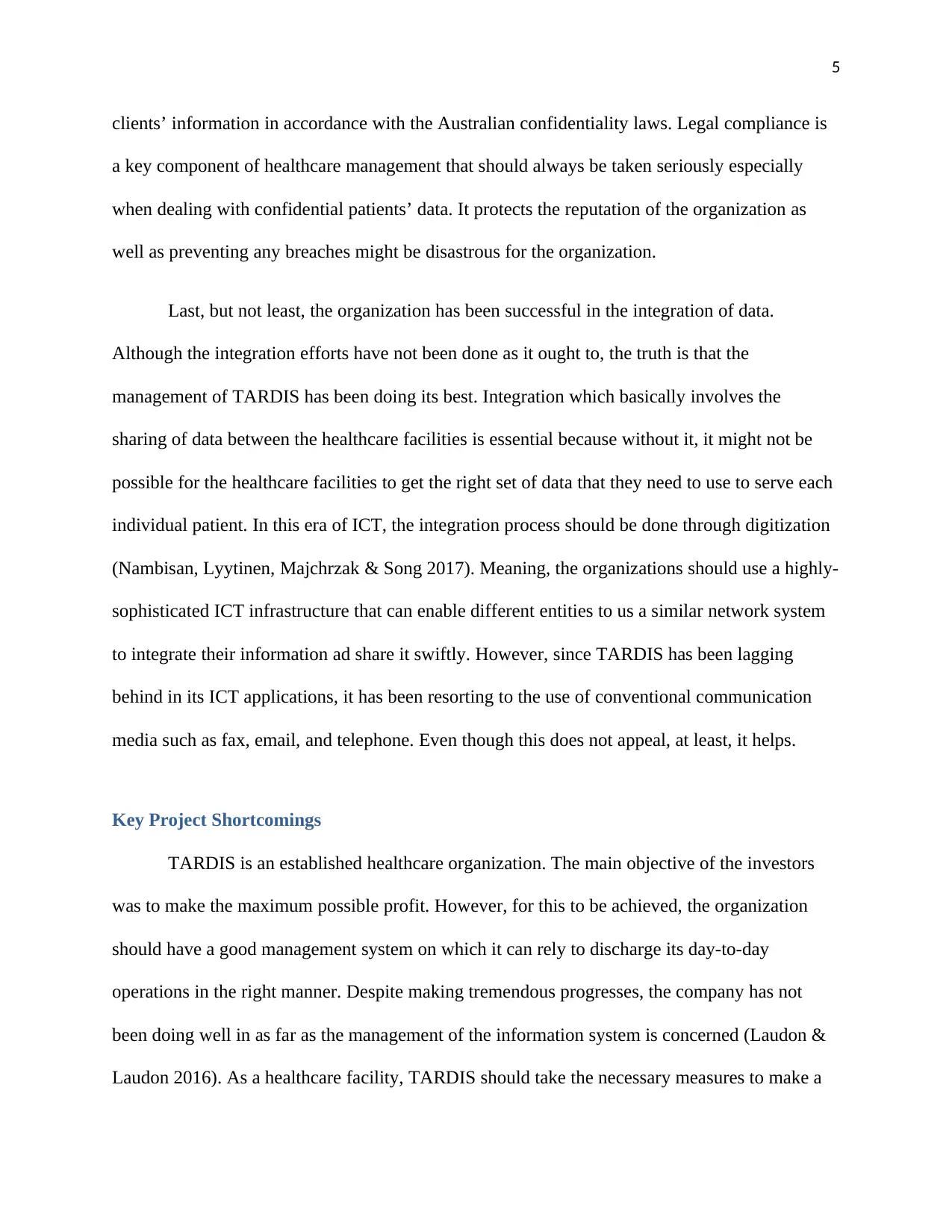
5
clients’ information in accordance with the Australian confidentiality laws. Legal compliance is
a key component of healthcare management that should always be taken seriously especially
when dealing with confidential patients’ data. It protects the reputation of the organization as
well as preventing any breaches might be disastrous for the organization.
Last, but not least, the organization has been successful in the integration of data.
Although the integration efforts have not been done as it ought to, the truth is that the
management of TARDIS has been doing its best. Integration which basically involves the
sharing of data between the healthcare facilities is essential because without it, it might not be
possible for the healthcare facilities to get the right set of data that they need to use to serve each
individual patient. In this era of ICT, the integration process should be done through digitization
(Nambisan, Lyytinen, Majchrzak & Song 2017). Meaning, the organizations should use a highly-
sophisticated ICT infrastructure that can enable different entities to us a similar network system
to integrate their information ad share it swiftly. However, since TARDIS has been lagging
behind in its ICT applications, it has been resorting to the use of conventional communication
media such as fax, email, and telephone. Even though this does not appeal, at least, it helps.
Key Project Shortcomings
TARDIS is an established healthcare organization. The main objective of the investors
was to make the maximum possible profit. However, for this to be achieved, the organization
should have a good management system on which it can rely to discharge its day-to-day
operations in the right manner. Despite making tremendous progresses, the company has not
been doing well in as far as the management of the information system is concerned (Laudon &
Laudon 2016). As a healthcare facility, TARDIS should take the necessary measures to make a
clients’ information in accordance with the Australian confidentiality laws. Legal compliance is
a key component of healthcare management that should always be taken seriously especially
when dealing with confidential patients’ data. It protects the reputation of the organization as
well as preventing any breaches might be disastrous for the organization.
Last, but not least, the organization has been successful in the integration of data.
Although the integration efforts have not been done as it ought to, the truth is that the
management of TARDIS has been doing its best. Integration which basically involves the
sharing of data between the healthcare facilities is essential because without it, it might not be
possible for the healthcare facilities to get the right set of data that they need to use to serve each
individual patient. In this era of ICT, the integration process should be done through digitization
(Nambisan, Lyytinen, Majchrzak & Song 2017). Meaning, the organizations should use a highly-
sophisticated ICT infrastructure that can enable different entities to us a similar network system
to integrate their information ad share it swiftly. However, since TARDIS has been lagging
behind in its ICT applications, it has been resorting to the use of conventional communication
media such as fax, email, and telephone. Even though this does not appeal, at least, it helps.
Key Project Shortcomings
TARDIS is an established healthcare organization. The main objective of the investors
was to make the maximum possible profit. However, for this to be achieved, the organization
should have a good management system on which it can rely to discharge its day-to-day
operations in the right manner. Despite making tremendous progresses, the company has not
been doing well in as far as the management of the information system is concerned (Laudon &
Laudon 2016). As a healthcare facility, TARDIS should take the necessary measures to make a
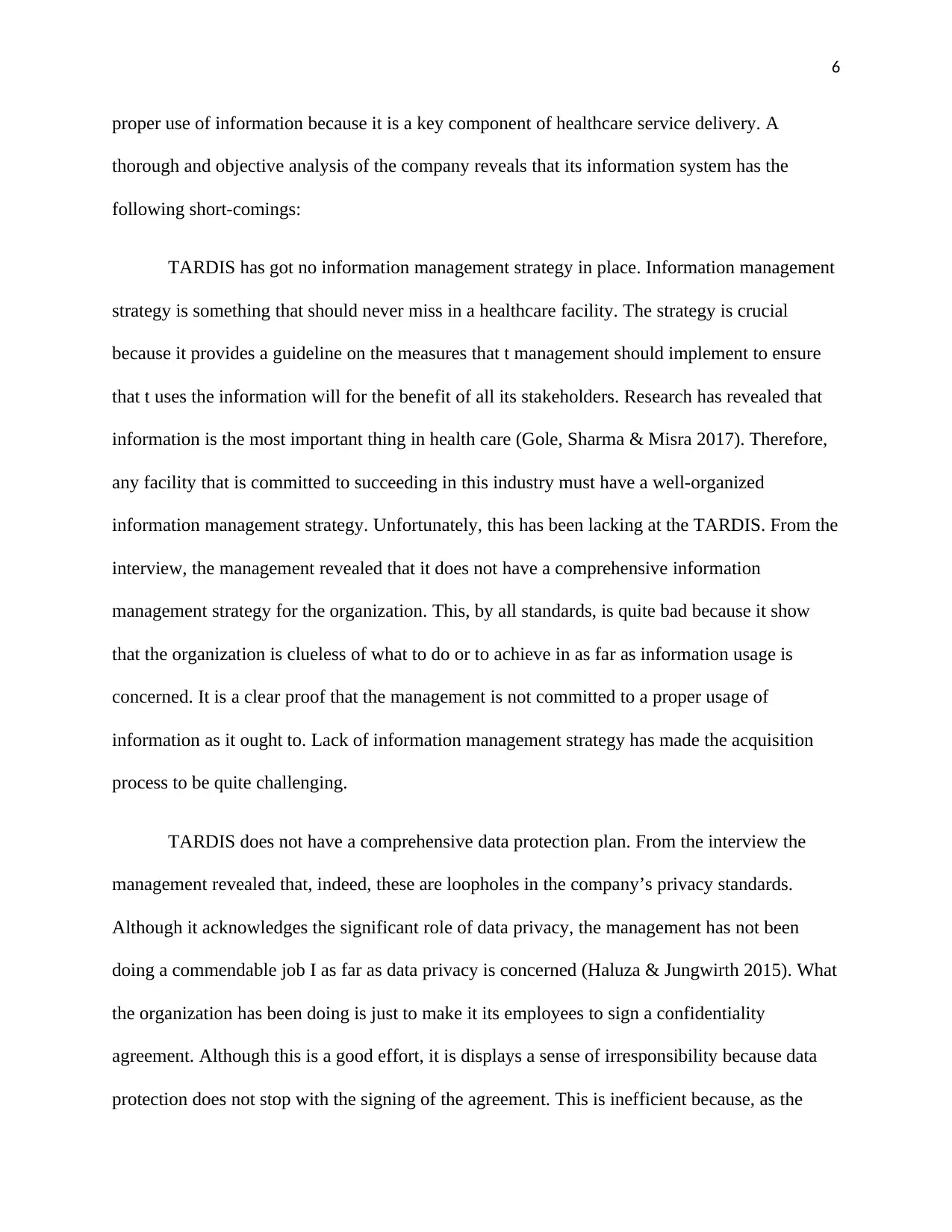
6
proper use of information because it is a key component of healthcare service delivery. A
thorough and objective analysis of the company reveals that its information system has the
following short-comings:
TARDIS has got no information management strategy in place. Information management
strategy is something that should never miss in a healthcare facility. The strategy is crucial
because it provides a guideline on the measures that t management should implement to ensure
that t uses the information will for the benefit of all its stakeholders. Research has revealed that
information is the most important thing in health care (Gole, Sharma & Misra 2017). Therefore,
any facility that is committed to succeeding in this industry must have a well-organized
information management strategy. Unfortunately, this has been lacking at the TARDIS. From the
interview, the management revealed that it does not have a comprehensive information
management strategy for the organization. This, by all standards, is quite bad because it show
that the organization is clueless of what to do or to achieve in as far as information usage is
concerned. It is a clear proof that the management is not committed to a proper usage of
information as it ought to. Lack of information management strategy has made the acquisition
process to be quite challenging.
TARDIS does not have a comprehensive data protection plan. From the interview the
management revealed that, indeed, these are loopholes in the company’s privacy standards.
Although it acknowledges the significant role of data privacy, the management has not been
doing a commendable job I as far as data privacy is concerned (Haluza & Jungwirth 2015). What
the organization has been doing is just to make it its employees to sign a confidentiality
agreement. Although this is a good effort, it is displays a sense of irresponsibility because data
protection does not stop with the signing of the agreement. This is inefficient because, as the
proper use of information because it is a key component of healthcare service delivery. A
thorough and objective analysis of the company reveals that its information system has the
following short-comings:
TARDIS has got no information management strategy in place. Information management
strategy is something that should never miss in a healthcare facility. The strategy is crucial
because it provides a guideline on the measures that t management should implement to ensure
that t uses the information will for the benefit of all its stakeholders. Research has revealed that
information is the most important thing in health care (Gole, Sharma & Misra 2017). Therefore,
any facility that is committed to succeeding in this industry must have a well-organized
information management strategy. Unfortunately, this has been lacking at the TARDIS. From the
interview, the management revealed that it does not have a comprehensive information
management strategy for the organization. This, by all standards, is quite bad because it show
that the organization is clueless of what to do or to achieve in as far as information usage is
concerned. It is a clear proof that the management is not committed to a proper usage of
information as it ought to. Lack of information management strategy has made the acquisition
process to be quite challenging.
TARDIS does not have a comprehensive data protection plan. From the interview the
management revealed that, indeed, these are loopholes in the company’s privacy standards.
Although it acknowledges the significant role of data privacy, the management has not been
doing a commendable job I as far as data privacy is concerned (Haluza & Jungwirth 2015). What
the organization has been doing is just to make it its employees to sign a confidentiality
agreement. Although this is a good effort, it is displays a sense of irresponsibility because data
protection does not stop with the signing of the agreement. This is inefficient because, as the
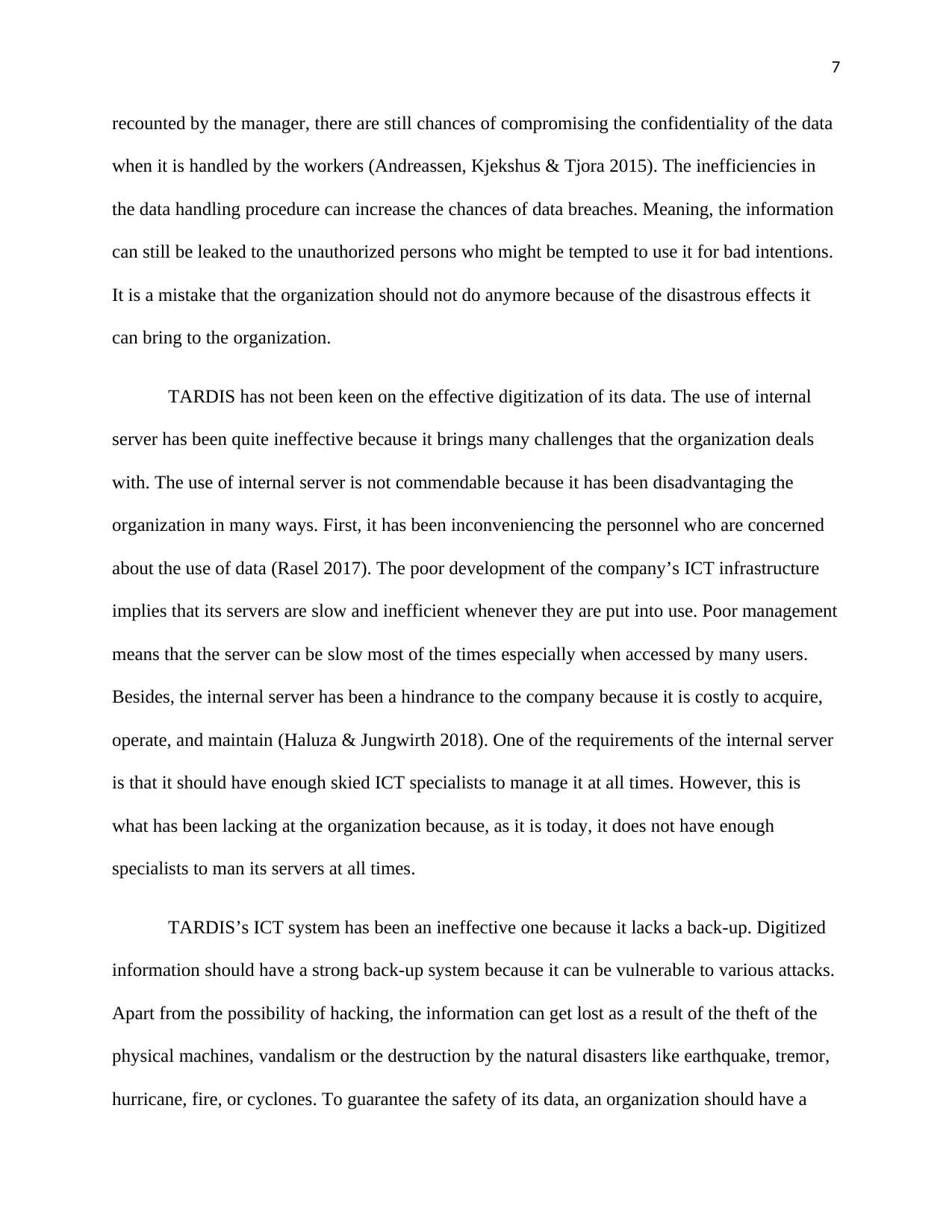
7
recounted by the manager, there are still chances of compromising the confidentiality of the data
when it is handled by the workers (Andreassen, Kjekshus & Tjora 2015). The inefficiencies in
the data handling procedure can increase the chances of data breaches. Meaning, the information
can still be leaked to the unauthorized persons who might be tempted to use it for bad intentions.
It is a mistake that the organization should not do anymore because of the disastrous effects it
can bring to the organization.
TARDIS has not been keen on the effective digitization of its data. The use of internal
server has been quite ineffective because it brings many challenges that the organization deals
with. The use of internal server is not commendable because it has been disadvantaging the
organization in many ways. First, it has been inconveniencing the personnel who are concerned
about the use of data (Rasel 2017). The poor development of the company’s ICT infrastructure
implies that its servers are slow and inefficient whenever they are put into use. Poor management
means that the server can be slow most of the times especially when accessed by many users.
Besides, the internal server has been a hindrance to the company because it is costly to acquire,
operate, and maintain (Haluza & Jungwirth 2018). One of the requirements of the internal server
is that it should have enough skied ICT specialists to manage it at all times. However, this is
what has been lacking at the organization because, as it is today, it does not have enough
specialists to man its servers at all times.
TARDIS’s ICT system has been an ineffective one because it lacks a back-up. Digitized
information should have a strong back-up system because it can be vulnerable to various attacks.
Apart from the possibility of hacking, the information can get lost as a result of the theft of the
physical machines, vandalism or the destruction by the natural disasters like earthquake, tremor,
hurricane, fire, or cyclones. To guarantee the safety of its data, an organization should have a
recounted by the manager, there are still chances of compromising the confidentiality of the data
when it is handled by the workers (Andreassen, Kjekshus & Tjora 2015). The inefficiencies in
the data handling procedure can increase the chances of data breaches. Meaning, the information
can still be leaked to the unauthorized persons who might be tempted to use it for bad intentions.
It is a mistake that the organization should not do anymore because of the disastrous effects it
can bring to the organization.
TARDIS has not been keen on the effective digitization of its data. The use of internal
server has been quite ineffective because it brings many challenges that the organization deals
with. The use of internal server is not commendable because it has been disadvantaging the
organization in many ways. First, it has been inconveniencing the personnel who are concerned
about the use of data (Rasel 2017). The poor development of the company’s ICT infrastructure
implies that its servers are slow and inefficient whenever they are put into use. Poor management
means that the server can be slow most of the times especially when accessed by many users.
Besides, the internal server has been a hindrance to the company because it is costly to acquire,
operate, and maintain (Haluza & Jungwirth 2018). One of the requirements of the internal server
is that it should have enough skied ICT specialists to manage it at all times. However, this is
what has been lacking at the organization because, as it is today, it does not have enough
specialists to man its servers at all times.
TARDIS’s ICT system has been an ineffective one because it lacks a back-up. Digitized
information should have a strong back-up system because it can be vulnerable to various attacks.
Apart from the possibility of hacking, the information can get lost as a result of the theft of the
physical machines, vandalism or the destruction by the natural disasters like earthquake, tremor,
hurricane, fire, or cyclones. To guarantee the safety of its data, an organization should have a
Paraphrase This Document
Need a fresh take? Get an instant paraphrase of this document with our AI Paraphraser
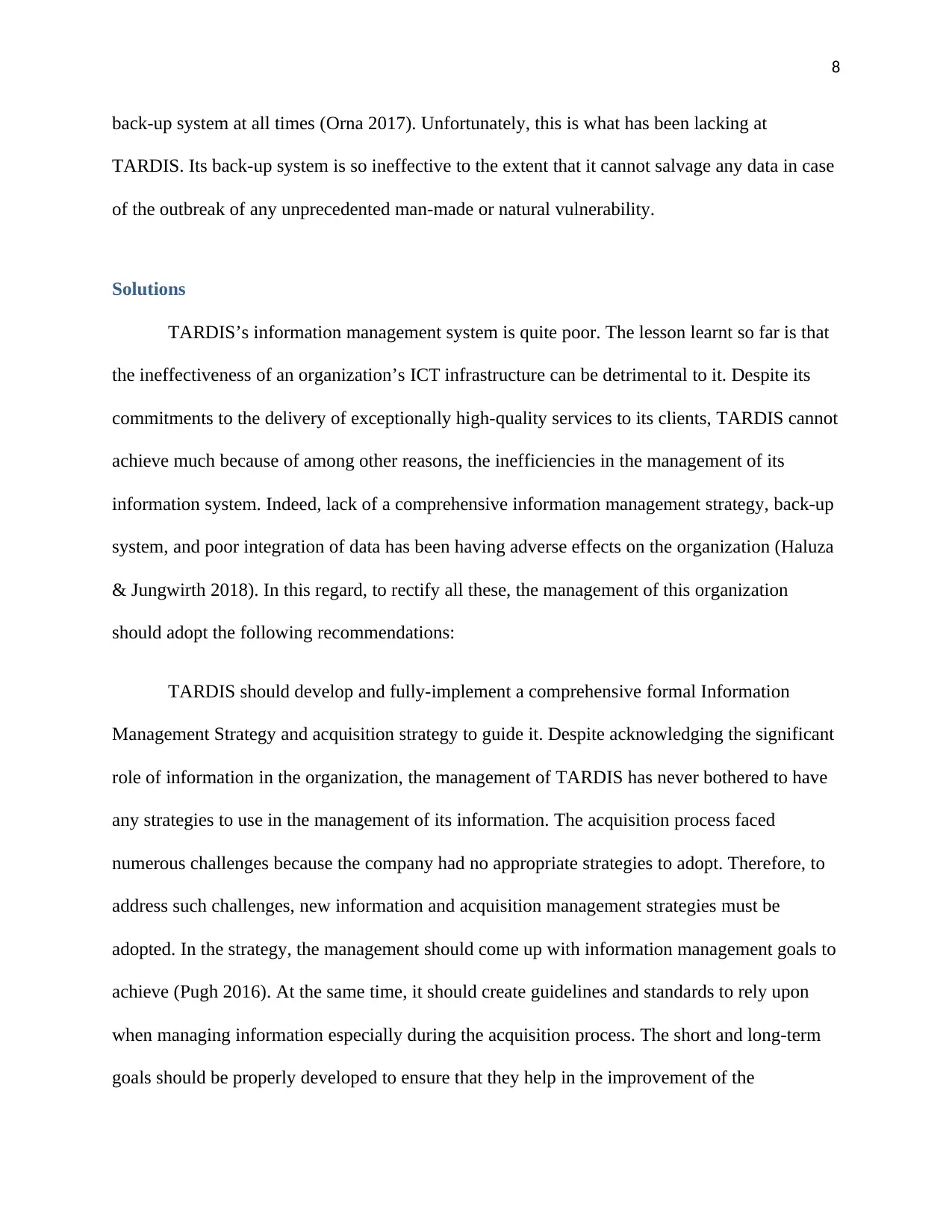
8
back-up system at all times (Orna 2017). Unfortunately, this is what has been lacking at
TARDIS. Its back-up system is so ineffective to the extent that it cannot salvage any data in case
of the outbreak of any unprecedented man-made or natural vulnerability.
Solutions
TARDIS’s information management system is quite poor. The lesson learnt so far is that
the ineffectiveness of an organization’s ICT infrastructure can be detrimental to it. Despite its
commitments to the delivery of exceptionally high-quality services to its clients, TARDIS cannot
achieve much because of among other reasons, the inefficiencies in the management of its
information system. Indeed, lack of a comprehensive information management strategy, back-up
system, and poor integration of data has been having adverse effects on the organization (Haluza
& Jungwirth 2018). In this regard, to rectify all these, the management of this organization
should adopt the following recommendations:
TARDIS should develop and fully-implement a comprehensive formal Information
Management Strategy and acquisition strategy to guide it. Despite acknowledging the significant
role of information in the organization, the management of TARDIS has never bothered to have
any strategies to use in the management of its information. The acquisition process faced
numerous challenges because the company had no appropriate strategies to adopt. Therefore, to
address such challenges, new information and acquisition management strategies must be
adopted. In the strategy, the management should come up with information management goals to
achieve (Pugh 2016). At the same time, it should create guidelines and standards to rely upon
when managing information especially during the acquisition process. The short and long-term
goals should be properly developed to ensure that they help in the improvement of the
back-up system at all times (Orna 2017). Unfortunately, this is what has been lacking at
TARDIS. Its back-up system is so ineffective to the extent that it cannot salvage any data in case
of the outbreak of any unprecedented man-made or natural vulnerability.
Solutions
TARDIS’s information management system is quite poor. The lesson learnt so far is that
the ineffectiveness of an organization’s ICT infrastructure can be detrimental to it. Despite its
commitments to the delivery of exceptionally high-quality services to its clients, TARDIS cannot
achieve much because of among other reasons, the inefficiencies in the management of its
information system. Indeed, lack of a comprehensive information management strategy, back-up
system, and poor integration of data has been having adverse effects on the organization (Haluza
& Jungwirth 2018). In this regard, to rectify all these, the management of this organization
should adopt the following recommendations:
TARDIS should develop and fully-implement a comprehensive formal Information
Management Strategy and acquisition strategy to guide it. Despite acknowledging the significant
role of information in the organization, the management of TARDIS has never bothered to have
any strategies to use in the management of its information. The acquisition process faced
numerous challenges because the company had no appropriate strategies to adopt. Therefore, to
address such challenges, new information and acquisition management strategies must be
adopted. In the strategy, the management should come up with information management goals to
achieve (Pugh 2016). At the same time, it should create guidelines and standards to rely upon
when managing information especially during the acquisition process. The short and long-term
goals should be properly developed to ensure that they help in the improvement of the
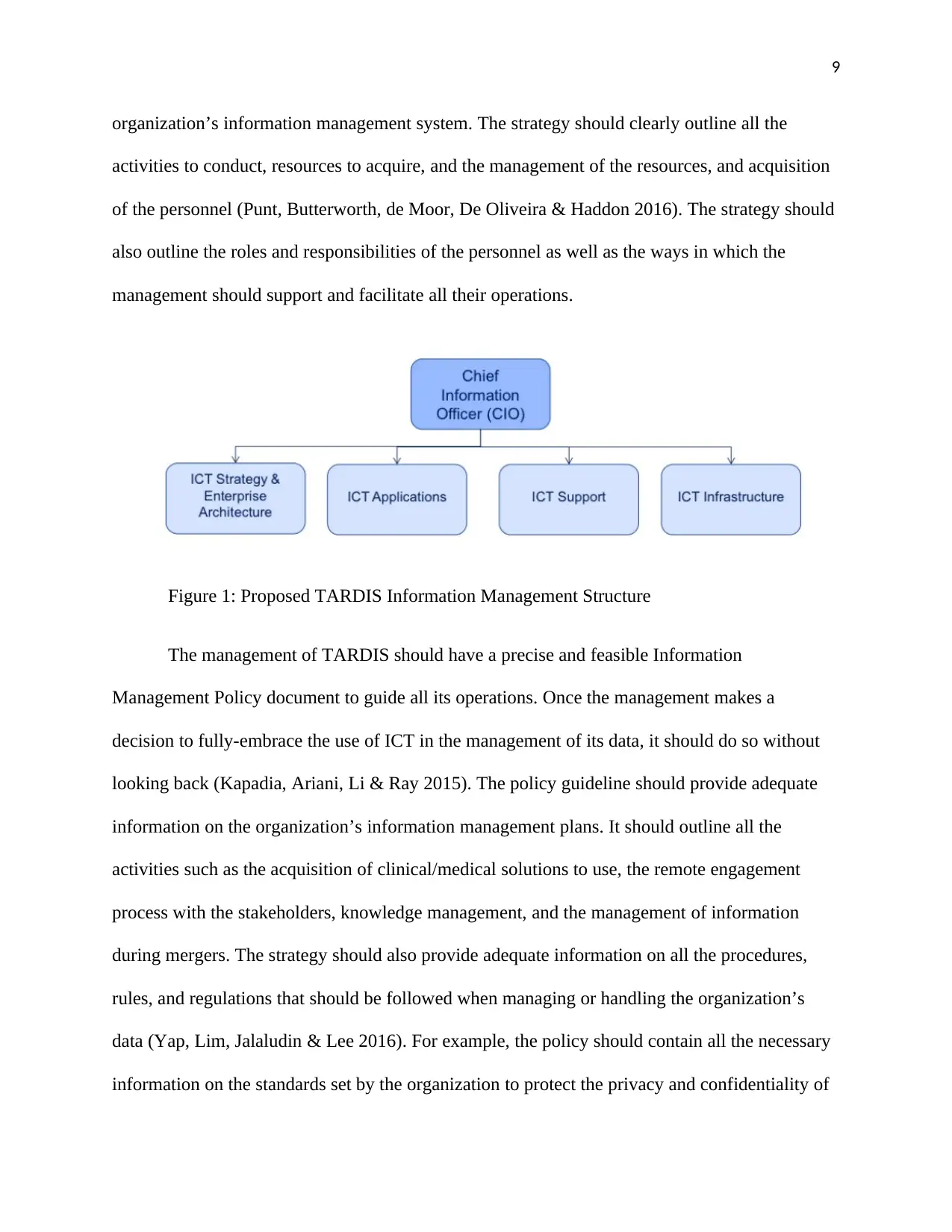
9
organization’s information management system. The strategy should clearly outline all the
activities to conduct, resources to acquire, and the management of the resources, and acquisition
of the personnel (Punt, Butterworth, de Moor, De Oliveira & Haddon 2016). The strategy should
also outline the roles and responsibilities of the personnel as well as the ways in which the
management should support and facilitate all their operations.
Figure 1: Proposed TARDIS Information Management Structure
The management of TARDIS should have a precise and feasible Information
Management Policy document to guide all its operations. Once the management makes a
decision to fully-embrace the use of ICT in the management of its data, it should do so without
looking back (Kapadia, Ariani, Li & Ray 2015). The policy guideline should provide adequate
information on the organization’s information management plans. It should outline all the
activities such as the acquisition of clinical/medical solutions to use, the remote engagement
process with the stakeholders, knowledge management, and the management of information
during mergers. The strategy should also provide adequate information on all the procedures,
rules, and regulations that should be followed when managing or handling the organization’s
data (Yap, Lim, Jalaludin & Lee 2016). For example, the policy should contain all the necessary
information on the standards set by the organization to protect the privacy and confidentiality of
organization’s information management system. The strategy should clearly outline all the
activities to conduct, resources to acquire, and the management of the resources, and acquisition
of the personnel (Punt, Butterworth, de Moor, De Oliveira & Haddon 2016). The strategy should
also outline the roles and responsibilities of the personnel as well as the ways in which the
management should support and facilitate all their operations.
Figure 1: Proposed TARDIS Information Management Structure
The management of TARDIS should have a precise and feasible Information
Management Policy document to guide all its operations. Once the management makes a
decision to fully-embrace the use of ICT in the management of its data, it should do so without
looking back (Kapadia, Ariani, Li & Ray 2015). The policy guideline should provide adequate
information on the organization’s information management plans. It should outline all the
activities such as the acquisition of clinical/medical solutions to use, the remote engagement
process with the stakeholders, knowledge management, and the management of information
during mergers. The strategy should also provide adequate information on all the procedures,
rules, and regulations that should be followed when managing or handling the organization’s
data (Yap, Lim, Jalaludin & Lee 2016). For example, the policy should contain all the necessary
information on the standards set by the organization to protect the privacy and confidentiality of
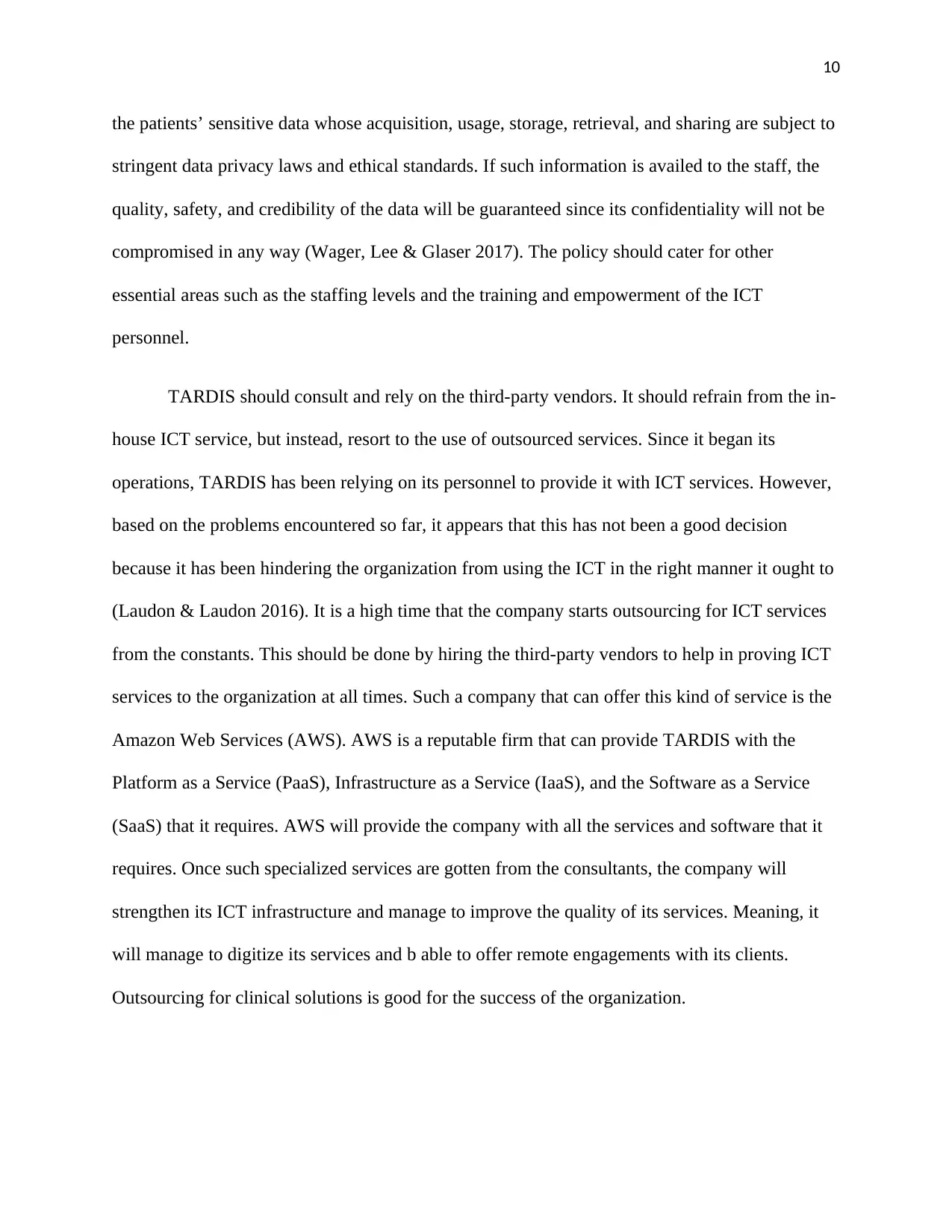
10
the patients’ sensitive data whose acquisition, usage, storage, retrieval, and sharing are subject to
stringent data privacy laws and ethical standards. If such information is availed to the staff, the
quality, safety, and credibility of the data will be guaranteed since its confidentiality will not be
compromised in any way (Wager, Lee & Glaser 2017). The policy should cater for other
essential areas such as the staffing levels and the training and empowerment of the ICT
personnel.
TARDIS should consult and rely on the third-party vendors. It should refrain from the in-
house ICT service, but instead, resort to the use of outsourced services. Since it began its
operations, TARDIS has been relying on its personnel to provide it with ICT services. However,
based on the problems encountered so far, it appears that this has not been a good decision
because it has been hindering the organization from using the ICT in the right manner it ought to
(Laudon & Laudon 2016). It is a high time that the company starts outsourcing for ICT services
from the constants. This should be done by hiring the third-party vendors to help in proving ICT
services to the organization at all times. Such a company that can offer this kind of service is the
Amazon Web Services (AWS). AWS is a reputable firm that can provide TARDIS with the
Platform as a Service (PaaS), Infrastructure as a Service (IaaS), and the Software as a Service
(SaaS) that it requires. AWS will provide the company with all the services and software that it
requires. Once such specialized services are gotten from the consultants, the company will
strengthen its ICT infrastructure and manage to improve the quality of its services. Meaning, it
will manage to digitize its services and b able to offer remote engagements with its clients.
Outsourcing for clinical solutions is good for the success of the organization.
the patients’ sensitive data whose acquisition, usage, storage, retrieval, and sharing are subject to
stringent data privacy laws and ethical standards. If such information is availed to the staff, the
quality, safety, and credibility of the data will be guaranteed since its confidentiality will not be
compromised in any way (Wager, Lee & Glaser 2017). The policy should cater for other
essential areas such as the staffing levels and the training and empowerment of the ICT
personnel.
TARDIS should consult and rely on the third-party vendors. It should refrain from the in-
house ICT service, but instead, resort to the use of outsourced services. Since it began its
operations, TARDIS has been relying on its personnel to provide it with ICT services. However,
based on the problems encountered so far, it appears that this has not been a good decision
because it has been hindering the organization from using the ICT in the right manner it ought to
(Laudon & Laudon 2016). It is a high time that the company starts outsourcing for ICT services
from the constants. This should be done by hiring the third-party vendors to help in proving ICT
services to the organization at all times. Such a company that can offer this kind of service is the
Amazon Web Services (AWS). AWS is a reputable firm that can provide TARDIS with the
Platform as a Service (PaaS), Infrastructure as a Service (IaaS), and the Software as a Service
(SaaS) that it requires. AWS will provide the company with all the services and software that it
requires. Once such specialized services are gotten from the consultants, the company will
strengthen its ICT infrastructure and manage to improve the quality of its services. Meaning, it
will manage to digitize its services and b able to offer remote engagements with its clients.
Outsourcing for clinical solutions is good for the success of the organization.
Secure Best Marks with AI Grader
Need help grading? Try our AI Grader for instant feedback on your assignments.
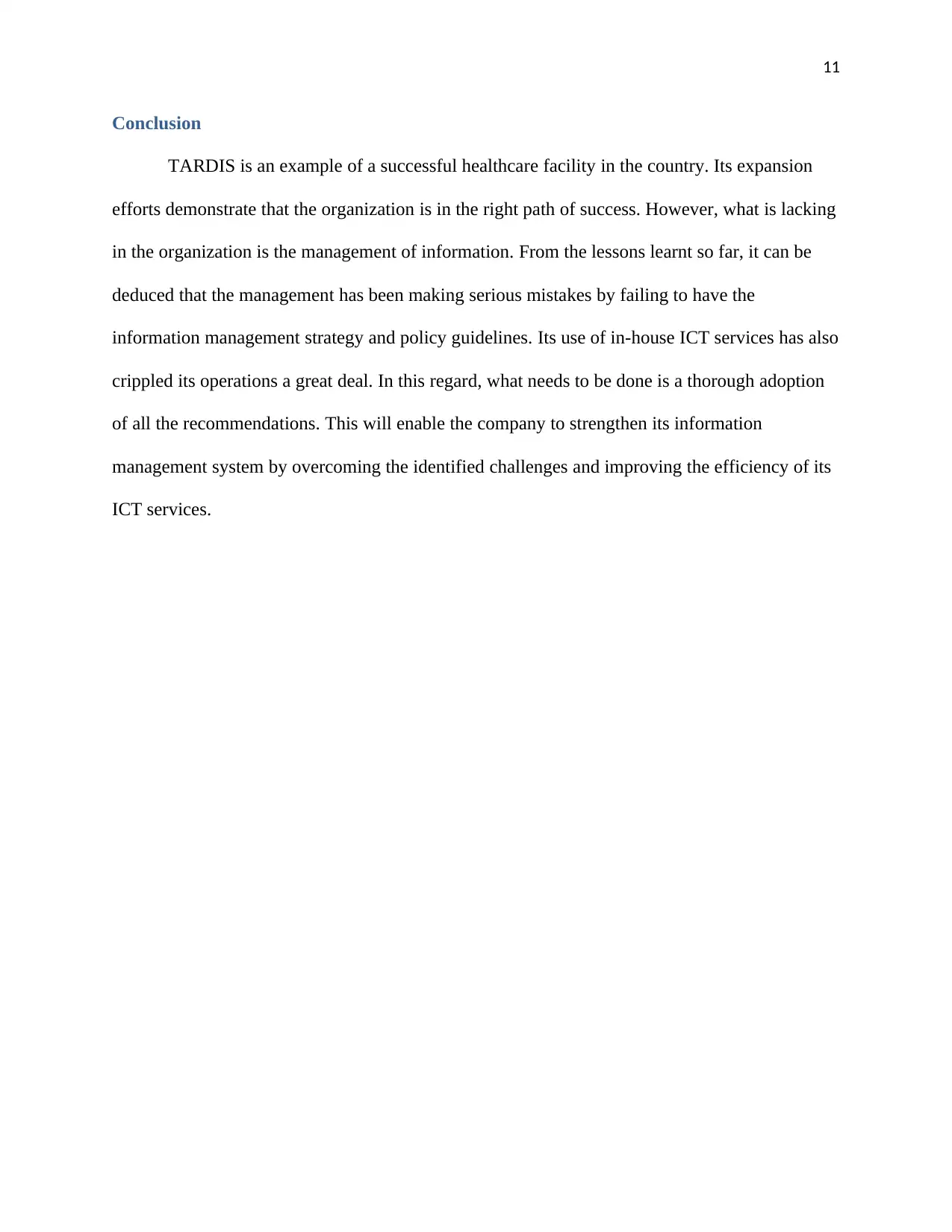
11
Conclusion
TARDIS is an example of a successful healthcare facility in the country. Its expansion
efforts demonstrate that the organization is in the right path of success. However, what is lacking
in the organization is the management of information. From the lessons learnt so far, it can be
deduced that the management has been making serious mistakes by failing to have the
information management strategy and policy guidelines. Its use of in-house ICT services has also
crippled its operations a great deal. In this regard, what needs to be done is a thorough adoption
of all the recommendations. This will enable the company to strengthen its information
management system by overcoming the identified challenges and improving the efficiency of its
ICT services.
Conclusion
TARDIS is an example of a successful healthcare facility in the country. Its expansion
efforts demonstrate that the organization is in the right path of success. However, what is lacking
in the organization is the management of information. From the lessons learnt so far, it can be
deduced that the management has been making serious mistakes by failing to have the
information management strategy and policy guidelines. Its use of in-house ICT services has also
crippled its operations a great deal. In this regard, what needs to be done is a thorough adoption
of all the recommendations. This will enable the company to strengthen its information
management system by overcoming the identified challenges and improving the efficiency of its
ICT services.
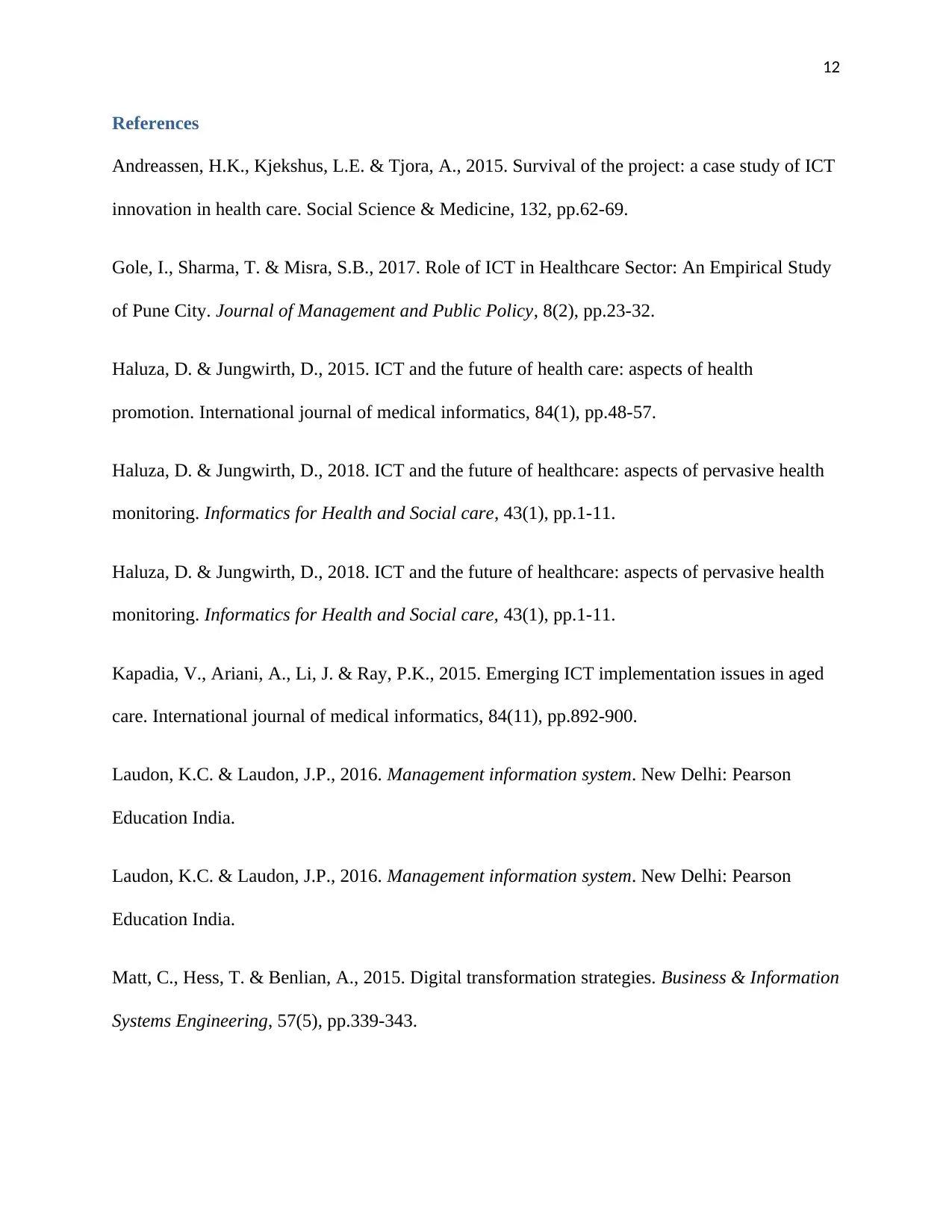
12
References
Andreassen, H.K., Kjekshus, L.E. & Tjora, A., 2015. Survival of the project: a case study of ICT
innovation in health care. Social Science & Medicine, 132, pp.62-69.
Gole, I., Sharma, T. & Misra, S.B., 2017. Role of ICT in Healthcare Sector: An Empirical Study
of Pune City. Journal of Management and Public Policy, 8(2), pp.23-32.
Haluza, D. & Jungwirth, D., 2015. ICT and the future of health care: aspects of health
promotion. International journal of medical informatics, 84(1), pp.48-57.
Haluza, D. & Jungwirth, D., 2018. ICT and the future of healthcare: aspects of pervasive health
monitoring. Informatics for Health and Social care, 43(1), pp.1-11.
Haluza, D. & Jungwirth, D., 2018. ICT and the future of healthcare: aspects of pervasive health
monitoring. Informatics for Health and Social care, 43(1), pp.1-11.
Kapadia, V., Ariani, A., Li, J. & Ray, P.K., 2015. Emerging ICT implementation issues in aged
care. International journal of medical informatics, 84(11), pp.892-900.
Laudon, K.C. & Laudon, J.P., 2016. Management information system. New Delhi: Pearson
Education India.
Laudon, K.C. & Laudon, J.P., 2016. Management information system. New Delhi: Pearson
Education India.
Matt, C., Hess, T. & Benlian, A., 2015. Digital transformation strategies. Business & Information
Systems Engineering, 57(5), pp.339-343.
References
Andreassen, H.K., Kjekshus, L.E. & Tjora, A., 2015. Survival of the project: a case study of ICT
innovation in health care. Social Science & Medicine, 132, pp.62-69.
Gole, I., Sharma, T. & Misra, S.B., 2017. Role of ICT in Healthcare Sector: An Empirical Study
of Pune City. Journal of Management and Public Policy, 8(2), pp.23-32.
Haluza, D. & Jungwirth, D., 2015. ICT and the future of health care: aspects of health
promotion. International journal of medical informatics, 84(1), pp.48-57.
Haluza, D. & Jungwirth, D., 2018. ICT and the future of healthcare: aspects of pervasive health
monitoring. Informatics for Health and Social care, 43(1), pp.1-11.
Haluza, D. & Jungwirth, D., 2018. ICT and the future of healthcare: aspects of pervasive health
monitoring. Informatics for Health and Social care, 43(1), pp.1-11.
Kapadia, V., Ariani, A., Li, J. & Ray, P.K., 2015. Emerging ICT implementation issues in aged
care. International journal of medical informatics, 84(11), pp.892-900.
Laudon, K.C. & Laudon, J.P., 2016. Management information system. New Delhi: Pearson
Education India.
Laudon, K.C. & Laudon, J.P., 2016. Management information system. New Delhi: Pearson
Education India.
Matt, C., Hess, T. & Benlian, A., 2015. Digital transformation strategies. Business & Information
Systems Engineering, 57(5), pp.339-343.
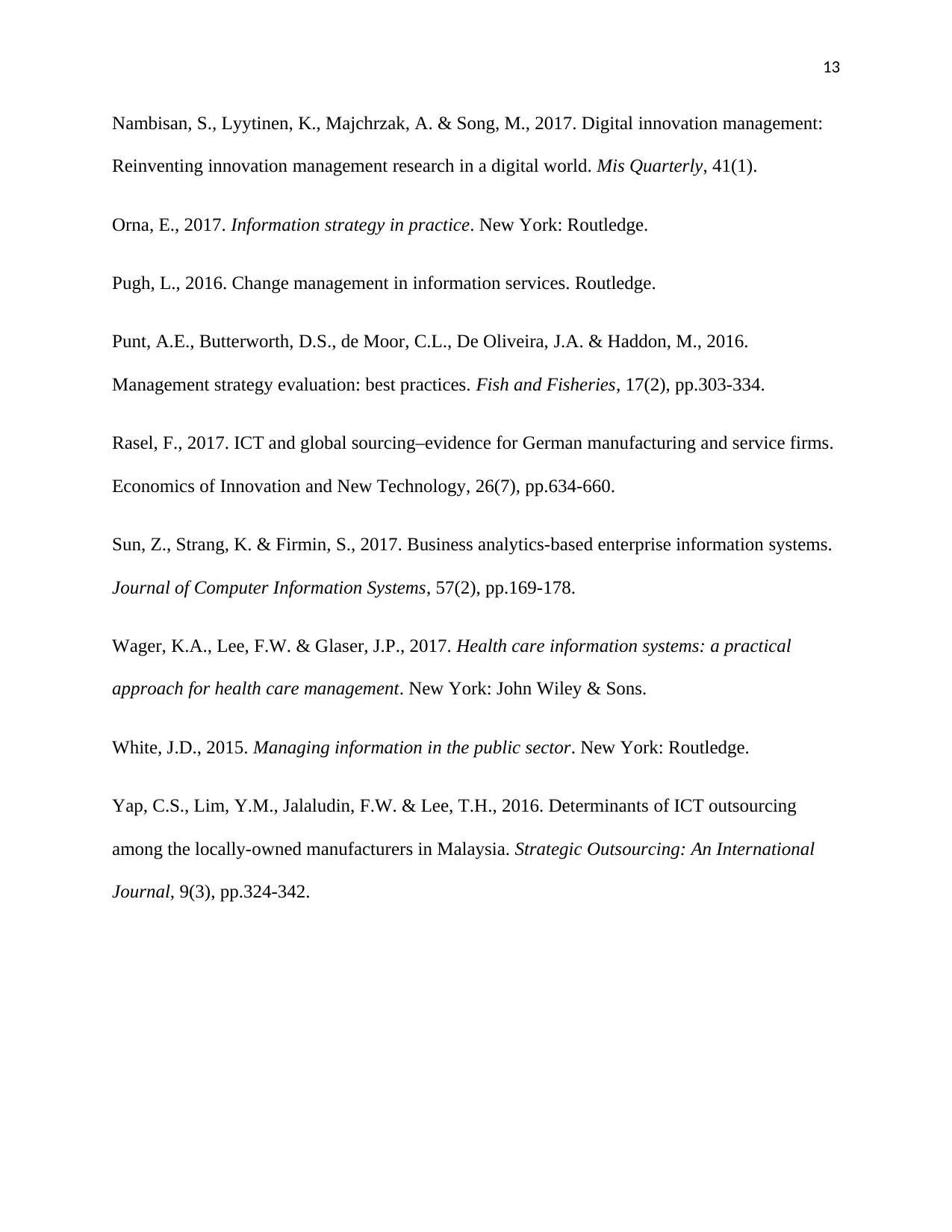
13
Nambisan, S., Lyytinen, K., Majchrzak, A. & Song, M., 2017. Digital innovation management:
Reinventing innovation management research in a digital world. Mis Quarterly, 41(1).
Orna, E., 2017. Information strategy in practice. New York: Routledge.
Pugh, L., 2016. Change management in information services. Routledge.
Punt, A.E., Butterworth, D.S., de Moor, C.L., De Oliveira, J.A. & Haddon, M., 2016.
Management strategy evaluation: best practices. Fish and Fisheries, 17(2), pp.303-334.
Rasel, F., 2017. ICT and global sourcing–evidence for German manufacturing and service firms.
Economics of Innovation and New Technology, 26(7), pp.634-660.
Sun, Z., Strang, K. & Firmin, S., 2017. Business analytics-based enterprise information systems.
Journal of Computer Information Systems, 57(2), pp.169-178.
Wager, K.A., Lee, F.W. & Glaser, J.P., 2017. Health care information systems: a practical
approach for health care management. New York: John Wiley & Sons.
White, J.D., 2015. Managing information in the public sector. New York: Routledge.
Yap, C.S., Lim, Y.M., Jalaludin, F.W. & Lee, T.H., 2016. Determinants of ICT outsourcing
among the locally-owned manufacturers in Malaysia. Strategic Outsourcing: An International
Journal, 9(3), pp.324-342.
Nambisan, S., Lyytinen, K., Majchrzak, A. & Song, M., 2017. Digital innovation management:
Reinventing innovation management research in a digital world. Mis Quarterly, 41(1).
Orna, E., 2017. Information strategy in practice. New York: Routledge.
Pugh, L., 2016. Change management in information services. Routledge.
Punt, A.E., Butterworth, D.S., de Moor, C.L., De Oliveira, J.A. & Haddon, M., 2016.
Management strategy evaluation: best practices. Fish and Fisheries, 17(2), pp.303-334.
Rasel, F., 2017. ICT and global sourcing–evidence for German manufacturing and service firms.
Economics of Innovation and New Technology, 26(7), pp.634-660.
Sun, Z., Strang, K. & Firmin, S., 2017. Business analytics-based enterprise information systems.
Journal of Computer Information Systems, 57(2), pp.169-178.
Wager, K.A., Lee, F.W. & Glaser, J.P., 2017. Health care information systems: a practical
approach for health care management. New York: John Wiley & Sons.
White, J.D., 2015. Managing information in the public sector. New York: Routledge.
Yap, C.S., Lim, Y.M., Jalaludin, F.W. & Lee, T.H., 2016. Determinants of ICT outsourcing
among the locally-owned manufacturers in Malaysia. Strategic Outsourcing: An International
Journal, 9(3), pp.324-342.
1 out of 13
Related Documents
Your All-in-One AI-Powered Toolkit for Academic Success.
+13062052269
info@desklib.com
Available 24*7 on WhatsApp / Email
![[object Object]](/_next/static/media/star-bottom.7253800d.svg)
Unlock your academic potential
© 2024 | Zucol Services PVT LTD | All rights reserved.





